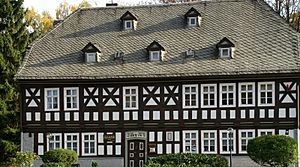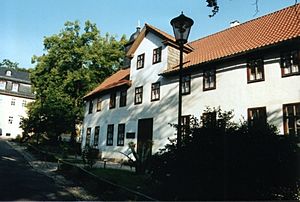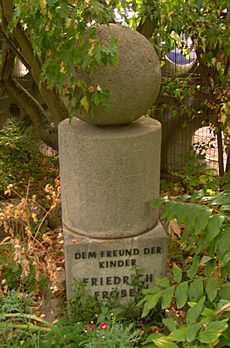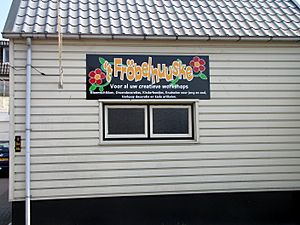Friedrich Fröbel facts for kids
Quick facts for kids
Friedrich Fröbel
|
|
|---|---|
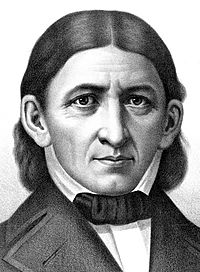 |
|
| Born |
Friedrich Wilhelm August Fröbel
21 April 1782 Oberweißbach, Schwarzburg-Rudolstadt, Holy Roman Empire
|
| Died | 21 June 1852 (aged 70) Schweina, Saxe-Meiningen, German Confederation
|
| Era | Modern philosophy
|
| Region | Western philosophy |
|
Main interests
|
Pedagogy |
|
Notable ideas
|
|
|
Influences
|
|
|
Influenced
|
|
Friedrich Wilhelm August Fröbel (born April 21, 1782 – died June 21, 1852) was a German educator. He is famous for creating the idea of the kindergarten. He believed that children learn best through play and by exploring their own interests. Fröbel also developed special educational toys called Froebel gifts. His ideas helped shape modern education.
Contents
Biography
Friedrich Fröbel was born in a village called Oberweißbach in Germany. His father was a pastor in the Lutheran church. This Christian faith was a big part of Fröbel's early life and learning.
Sadly, Fröbel's mother passed away when he was only nine months old. This event had a deep impact on him. When he was 10, he went to live with his kind uncle in a different town.
At 15, Fröbel, who loved nature, started training to be a forester. But he later decided to study mathematics and botany at a university. For a few years, he worked as a land surveyor.
Fröbel married Wilhelmine Henriette Hoffmeister in 1818, but they did not have children. After she passed away in 1839, he married Louise Levin in 1851.
Career as an Educator
Fröbel's career often combined his love for nature with his passion for education. In 1805, he started working as a teacher in Frankfurt. There, he learned about the ideas of another famous educator, Johann Heinrich Pestalozzi. Fröbel even lived and worked with Pestalozzi in Switzerland for a few years.
Later, Fröbel served in the military from 1813 to 1814, fighting against Napoleon. During this time, he made friends with two other educators, Wilhelm Middendorf and Heinrich Langethal. They would become important colleagues.
After his military service, Fröbel worked at a museum studying mineral crystals. He was fascinated by their shapes and how they grew. He realized that even "lifeless" stones had a pattern of development. This helped him understand how humans also grow and develop.
In 1816, Fröbel started his own school, the German General Education Institute. A year later, he moved the school to Keilhau. His friends Middendorf and Langethal continued his work there.
In 1826, Fröbel published his most important book, Die Menschenerziehung (which means "The Education of Man").
The First Kindergarten
Fröbel returned to Germany in 1836 and focused on teaching young children. In 1837, he opened a special place for small children in Bad Blankenburg. In 1840, he gave this place a new name: kindergarten. This German word means "children's garden." He believed children should grow and learn like plants in a garden.
Fröbel designed special educational toys, known as Froebel Gifts. These included geometric blocks and pattern sets. These toys helped children learn about shapes, numbers, and creativity through play.
A key idea from Fröbel was "free work" (Freiarbeit). He believed children should be allowed to choose their activities and learn at their own pace. He also saw play as a very important way for children to learn. In the first kindergartens, children would sing, dance, do gardening, and play with the Froebel Gifts.
A supporter named Baroness Bertha von Marenholtz-Bülow helped spread Fröbel's ideas. She introduced his work to important people and royal families. She also helped Fröbel train the first women to become kindergarten teachers.
However, in 1851, the government in Prussia (a part of Germany) banned kindergartens. They thought Fröbel's ideas were dangerous. This made Fröbel very sad. He passed away on June 21, 1852.
Legacy
Even though kindergartens were banned in Prussia, Fröbel's ideas spread. Many teachers left Germany and took his methods to other countries.
- In 1856, Fröbel's student Margarethe Schurz opened the first kindergarten in the United States in Wisconsin.
- Elizabeth Peabody was inspired by Schurz and opened the first English-speaking kindergarten in Boston in 1860.
- Missionary women also brought Fröbel's ideas to Japan, training many Japanese women to be kindergarten teachers.
The ban on kindergartens in Germany was eventually lifted. In 1863, the German Fröbel Association was formed to continue his work. Today, many kindergartens in Germany are named after Fröbel and still use his teaching methods.
Fröbel's legacy also lives on through colleges that train teachers. Froebel College in London, for example, continues his traditions. The Pestalozzi-Fröbel-Haus in Berlin also trains nursery school teachers.
In the United States, April 21, Fröbel's birthday, is celebrated as National Kindergarten Day.
Cultural Influence
Fröbel's ideas about building forms and movement games influenced abstract art. They also inspired the famous Bauhaus movement in architecture and design. Many well-known architects, like Frank Lloyd Wright, Le Corbusier, and Buckminster Fuller, learned about Fröbel's ideas on geometry when they were children.
Works
Friedrich Fröbel wrote several books about his educational ideas. Here are a few of them:
- An unser deutsches Volk (To Our German People). Erfurt 1820.
- Die Menschenerziehung (The Education of Man). Keilhau-Leipzig 1826.
See also
 In Spanish: Friedrich Fröbel para niños
In Spanish: Friedrich Fröbel para niños


